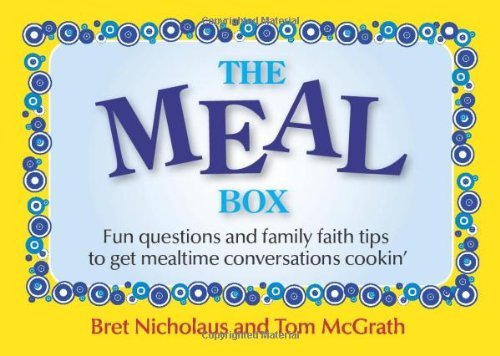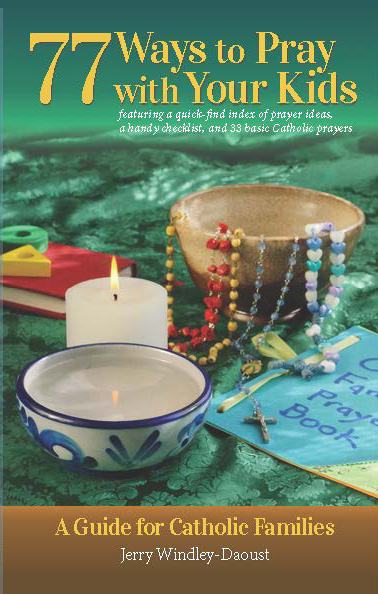A Jump for Family Life: The Meal Box and 77 Ways to Pray
I’d like to say “Ask any parent what strikes terror in their hearts and they’re sure to say mealtimes and prayer times.” But I’m not sure it’s an accurate statement, because my sample size is exactly one: myself.
Admittedly, mealtimes don’t scare me quite the way now, ten years into this parenting gig, as they did back in the earlier days, before I was at least passable as a cook and a bit unfazed by late-day drama.
We have a standing tradition, inspired by my sister-in-law’s family, of going around the table in what my four-year-old calls the “Bets Parts Worts Parts Game.” Every person takes a turn sharing the best part of their day, and then we go around and share the worst part of our days.
It’s a light into each person’s day and state of mind, and it can be quite amusing. My husband, for example, never fails to say that his best part is coming home. (And I never fail to be a bit smitten by his smile as he says it.) The kids have made a game out of this, and one night, the two older ones insisted that their best parts were also coming home and that it no longer counted.
Despite the conversation this can inspire — and oh, it does! — I sometimes want to have a more directed sort of conversation. The problem, though, is that by dinnertime, my creative juices are at about their lowest point. I’m in a form of survival mode, and coming up with good conversation is usually beyond me.

It’s a collection of 54 cards, each with a conversation starter and a faith application tip. The green side is the side we’ve been focusing on; it’s the conversation starter. The yellow side is “Food for Family Thought,” and is a bit harder to explain to the younger crew (though my ten-year-old finds them intriguing, and so do I). They seem to be aimed more at parents and less at the kids, which is why we’ve been focusing more on the conversation side.
Next up in the Reinhard house, for example, is this:
Conversation Starter: The fish and the cross are two symbols commonly used to represent the Christian faith. If you were asked to create a new symbol that would represent faith, what would it look like?
Food for Family Thought: As birthdays and other gift-giving occasions arise, think to include at least one gift that speaks of faith to your child. It can be a book, a medal, or a DVD that reinforces good values. It could even be as simple as a Bible verse bookmark. It will show that you value your child’s spiritual nature.
They’re not all overtly religious; we’ve had discussions about what kind of park we would build, how we would rank the months of the year, and what four new faces we’d carve in Mount Rushmore. The conversations have been interesting, and we’ve laughed a lot. It’s made sitting down to dinner together better and different. It’s also given me tons of other ideas for integrating conversation topics into other times when our family is together, like in the van on the way here or there.
OK, dinnertime is covered. (Well, sort of.)
But prayer time? Well, you have me there. I am at square one with this, and I won’t even defend myself.

Windley-Daoust is a dad who’s been really hands-on with his kids: he’s the stay-home parent, as a matter of fact, and his involvement (and his background in writing) is apparent throughout the book.
This is not a book you read cover-to-cover (though, if you’re like me, you’ll at least glance through it all before you shake your head and thank God for the gift it is). It’s a guidebook and a reference, the kind you dog-ear and then revisit again and again.
Each of the 77 ways Windley-Daoust outlines is rated by ease of use and age-level appropriateness. Most of them include options for both older teens and younger children, and there are a lot of additional talking points.
In other words, you’re not doing this alone. The Introduction outlines both how to use the book and provides great preparation for those of us who may not be so good at this right out of the gate.
You’ll learn as you go through it: about the Catholic faith, about your own limitations, and about ways to pray. Even if you’re an old pro, I can’t help but think that there’s something in this book for you: maybe a new idea, maybe a new approach, maybe just a new sense of the importance of prayer.
The book is divided into sections: How to Pray Together, Times to Pray Together, Ways to Pray Together, and Helps for Praying Together. In the back, there’s an index that’s also a checklist.
There are things you can implement with little or no extra effort (no, really!). Take, for example, this, rated for all ages, with an “E” for easy:
Pray for Emergency Vehicles
When you hear an emergency vehicle’s siren, say a short prayer for the emergency responders and the people they are going to help. You can pray an Our Father, or even something as simple as, “God, please be with the people who are scared and needing help; please be with the emergency helpers to keep them safe and to help them to know what to do.” Close with the Sign of the Cross.
Talking Points: The Power of Prayer
You can point out to your children that God wants us to help those in need — personally, with our own hands, if possible. (You can tell them the parable of the Good Samaritan, found in Luke 10:25-37.) However, when it is impossible to help someone personally, God gives us the opportunity to reach out to people in need through our prayer. When we pray for those in need, we participate in God’s work in their lives.
Learn more:
Catechism of the Catholic Church 2634-2636
Not every item has talking points or learn more sections; some have tips for getting started, coping mechanisms, and/or older children and teens sections in addition or instead of those sections.
This is truly a book that will help you turn praying with your kids into an ongoing experience, not an isolated moment each day. I think it’s going to help me pray more consciously as a parent, and it will aid me in sharing that with my children.
Another great bonus (and one you don’t have to buy the book to appreciate) is the website of supporting material, which includes both an online index with ideas from the book and a whole page (that’s being updated regularly with new content!) of ideas and helps.
This is the kind of resource that I’ve needed. It’s easy to use and simple to understand, but it leaves room for growth while making the challenge that you get up and start growing.
And, on the edge of Lent, I can think of few books better to have in my hand than this one.















